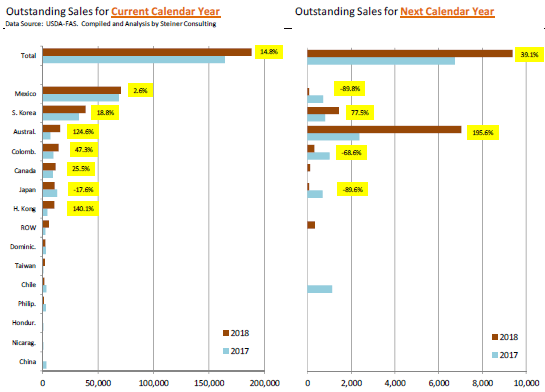



CME: Sharp increase in hog futures for 2019 since August
As hog supplies start to seasonally increase, markets will increasingly focus on the pace of exports and the ability of processors to push more product into export channels, according to Steiner Consulting Group, DLR Division, Inc.Hog futures for 2019 have increased sharply since August, in large part due to speculation about the impact of African Swine Fever on global pork supplies and consequently demand for US pork. That speculation will be put to a test in the coming weeks and months and futures will adjust risk premiums accordingly.
Each week USDA reports on pork export shipments and sales of pork muscle cuts, an important and timely gauge of product flows outside of the US. It is important to note that the report only covers muscle cuts, it does not tell us about sales of hog carcasses or sales of by-products.
So what did we learn from the report that was published for exports/sales week ending 11 October? Exports for the week were 25,691 MT, 22% higher than a year ago. In the four weeks ending 11 October pork exports have averaged 22,503 MT/wk, 8% higher than the same period last year.
The increase in exports should not be a surprise given that outstanding sales remain well above year ago levels. In this last report USDA noted that total current year outstanding sales, i.e. product that has been sold but not yet shipped, are almost 15% higher than a year ago.
It is interesting to look at the following chart and recognize how small a part of US outstanding sales China was last year. While sales to that market have ground to a halt, the impact on US pork export potential through year end is quite small.

Some media reports have noted the fact that higher tariffs on US pork in China have significantly limited the potential for US pork export sales, which may be true in a narrow sense. However, what should also be noted is that China has always been a relatively small part of the US pork export mosaic.
The potential lifting of Mexican tariffs on US hams next year, following ratification of USMCA, should be a very important positive development. Additionally, one should recognize that there are only a few major pork exporters in the world, with EU and USA being the two largest.

If China starts to pull more product from the EU in order to cover some of their production shortfall, this means this will tend to be inflationary for the entire global pork supply chain. USA hog prices still hold a notable price advantage vs. EU hogs although the US discount has narrowed significantly in recent weeks.
US hog supplies are expanding at a faster rate than in the EU, which ultimately should bolster US export potential if global demand improves. The inventory of breeding pigs in the EU for the period May- Jun was down 1% compared to the same quarter the previous year.
On the other hand, US breeding pig inventories were up 3.7% in the June quarter. Despite recent speculation about Chinese demand, hog prices in the EU are trending lower at a time that their feed costs are trending up, not a good recipe for expansion.
Anecdotal evidence notwithstanding, at this time US pork industry has both the supply and price advantage to expand into a number of markets. Outstanding pork sales for 2019 are currently running 39% higher than a year ago. Lower prices for hams/butts in Nov/Dec should translate into more sales booked for next year.








